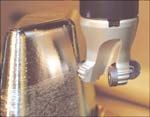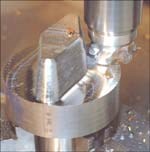Metal Removal System Reduces Machining Time
A difficult setup for machining can be time consuming, especially when a large amount of stock needs to be removed and there is little of the part to hold. This delicate process can lead to increased cycle times and a drop in production.
Share





Cambron Engineering (Bay City, Michigan) has been in business since 1972. Specializing in designing and building a range of tools, dies, molds, gages, fixtures and assemblies, the company is employee-owned and strives to provide quality products.
A difficult setup for machining can be time consuming, especially when a large amount of stock needs to be removed and there is little of the part to hold. This delicate process can lead to increased cycle times and a drop in production. Bryon Christilaw, Cambron Engineering Inc.'s CNC supervisor was able to address this problem by applying Fast Metal Removal (FMR) from Iscar Metals, Inc. (Arlington, Texas) tooling to the project.
For this particular project, the part being machined was 8620 steel and was fairly tall, with a large amount of stock to be removed. The shape of the piece made it difficult to hold; therefore, machining proved problematic. A round boss on the bottom of the part was the only surface to hold. A three-jaw chuck was used to clamp the part, while a dowel pin was used to keep the part from moving radially. Because of the poor rigidity of the piece, vibration was also a concern.
Because there is very little to hold on to while machining, it was crucial that the cutting tool produce minimal side pressure onto the part. The Feedmill was recommended because many of the cutting forces are directed axially up the spindle, which helps reduce vibration and chatter on the workpiece. This is accomplished through the use of triangular-shaped positive inserts. The company says these inserts have a large radius cutting edge configuration that allows above average feed rates. As a result, the subsequent cutting forces are directed axially, producing slight pressure on the part.
Cambron operated the Feedmill at 950 rpm and 280 ipm, ramping at 0.030" depth of cut per 360 degrees. The total time to rough a part was 20 minutes, which the company says is a significant reduction from the previous setup, which took several hours.
The Feedmill also allowed Cambron to rough an unusually shaped part. Once the roughing was completed, Iscar's Millshred was used to finish the product. The Millshred is a new milling tool that is available with either traditional round inserts or serrated inserts. The serrated inserts have four indexing orientation options and are designed so that they overlap. This provides a “fully effective” cutter configuration for machining. If round inserts are used, there are eight indexing orientation options. Like the Feedmill, the Millshred is also designed to remove metal quickly and can be used for long tool overhangs. The Millshred portion of the project was operated at 1,700 rpm and 419 ipm, taking a 0.030" depth of cut per 360 degrees. This process took 10 minutes per part and was accomplished with one set of inserts.
Cambron reports that this combination allowed the company to cut its roughing cycle time. The FMR design enabled it “to machine this unusually shaped part in approximately 30 minutes when it took hours with the previous setup.” With the majority of the cutting forces traveling back into the spindle and not into the part, it was possible to keep the part stable throughout the machining process, which increased the speeds and feeds, therefore reducing cycle time.
Read Next
Registration Now Open for the Precision Machining Technology Show (PMTS) 2025
The precision machining industry’s premier event returns to Cleveland, OH, April 1-3.
Read MoreSetting Up the Building Blocks for a Digital Factory
Woodward Inc. spent over a year developing an API to connect machines to its digital factory. Caron Engineering’s MiConnect has cut most of this process while also granting the shop greater access to machine information.
Read MoreBuilding Out a Foundation for Student Machinists
Autodesk and Haas have teamed up to produce an introductory course for students that covers the basics of CAD, CAM and CNC while providing them with a portfolio part.
Read More























.jpg;maxWidth=300;quality=90)







